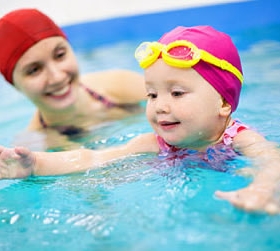Article at a Glance
When we think of somebody drowning, we picture a lot of splashing and yelling—like what we see on TV. But in reality drowning looks nothing like that. Which is why over half of the cases of children drowning that occur each year happen within 25 yards of adult supervision. In ten percent of these cases, an adult actually watched the child drown without knowing what was happening.
Feeling a little bit scared? You should be. For children ages 1 to 14, drowning is the second-leading cause of unintentional injury-related death—behind motor vehicle accidents. And for children ages 1 to 4, drowning is responsible for more deaths than any other cause except birth defects. According to the Centers for Disease Control and Prevention, there are an average of 3,533 fatal, non-boating related, unintentional drownings each year in the United States.
Before you head out to the water again this summer, it is important for you to know exactly what drowning looks like. When people are drowning or feel like they are drowning, their instincts kick in. The body’s primary objective is to keep itself above the water’s surface—not signal for help.
What Happens When Drowning
What To Look For
Drowning can happen surprisingly fast. A drowning person can usually only stay above the water 20 to 60 seconds. That is why it is so important to know what to look for and to act quickly.
Signs of Drowning:
If somebody is yelling and thrashing around in the water, it doesn’t mean that they don’t need help. Before true drowning occurs, occasionally people experience aquatic distress. At this point they are still able to control their responses and assist in their rescue.
If you notice any of the above warning signs, it is important to act quickly. It only takes two minutes for a child who is underwater to lose consciousness and only four to six minutes to suffer irreversible brain damage.
How to Protect Your Child
Constant Supervision:
When children play in or around water, it is important that they are under your constant supervision. Drowning can happen very quickly. It can take just seconds for a child to get themselves into a dangerous situation. Even if your child knows how to swim or if there is a lifeguard present, it is important to keep your eyes on your child at all times. Avoid any distracting activities like reading, talking on the phone, gardening, or drinking alcohol. Be worried if things get quiet. Children make a lot of noise when playing in the water and silence can mean that there might be a problem.
For younger children, it is important to provide “touch supervision.” This means that you are close enough to touch your child at all times.
Just because your child is not playing in the water, does not mean that they aren’t in danger. Nearby ponds, small plastic pools, or unfenced pools can be a danger. Children can wander off and drown before parents even know that they are missing. And it doesn’t take much water. Even older children have been known to drown in very small bodies of water.
Only allow your children to play around water when you are present or if they are with a responsible adult who you know you can trust to keep an eye on your children at all times.
Fences and Boundaries:
If you own a pool, make sure you have appropriate fencing around the pool and that you don’t leave any toys in or around the pool that may be attractive to a child. Don’t leave standing water in inflatable or small plastic pools.
Learn CPR:
Parents should learn CPR. In an emergency, seconds count and the sooner you start CPR the better. Being able to start CPR before the ambulance arrives can mean the difference between life and death.
Swim Lessons:
Studies have shown that taking swimming lessons can reduce the risk of drowning. According to the AAP, children are ready for swim lessons around the age of 4. Before then, children typically do not have the coordination or physical and mental ability.
Flotation Devices:
Know the difference between inflatable and foam water toys and U.S. Coast Guard approved life jackets. Children can easily slip off of toys or out of water wings and should not be relied upon as life jackets.
For more information on water safety
